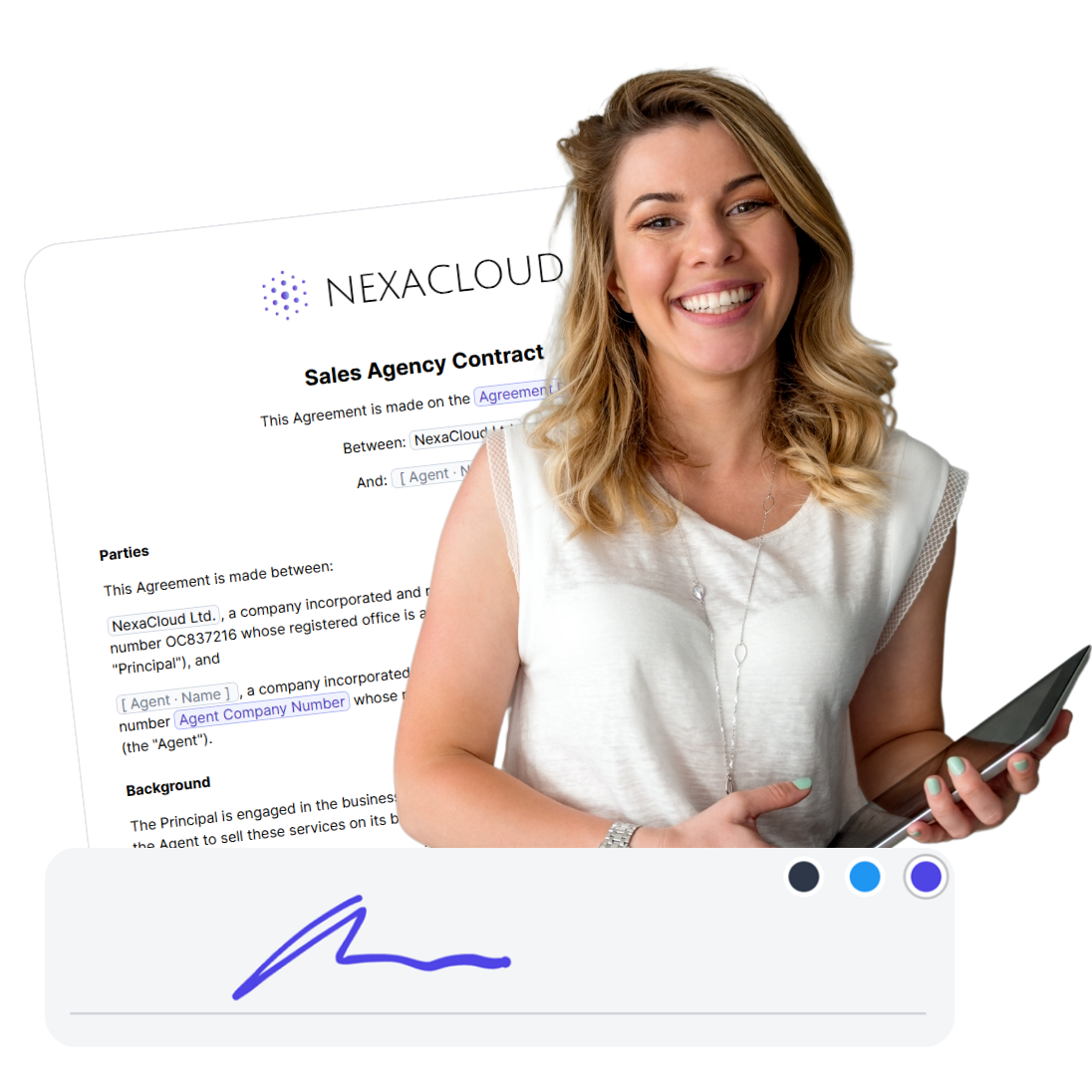How to run a contract management audit efficiently
Contract management audits are one of the most effective ways to understand whether your contract processes are working as intended or quietly putting your business at risk. Most companies don’t realize how many gaps, inconsistencies, or outdated practices sit inside their contract workflows until an audit exposes them. A good contract management audit helps you spot those issues early, fix what’s broken, and build a system that’s reliable, compliant, and scalable. This guide walks you through what a contract audit is, why it matters, how to prepare, what to review, and how modern tools like fynk make the entire process faster and more transparent.
- What is a contract management audit
- Why contract management audits matter
- When to conduct a contract audit
- Before the audit: Preparing for a contract management audit
- During the audit: what to review and how to assess it
- After the audit: reporting, improvements, and next steps
- How fynk supports a complete, audit-ready contract management audit
- Contract management audit checklist
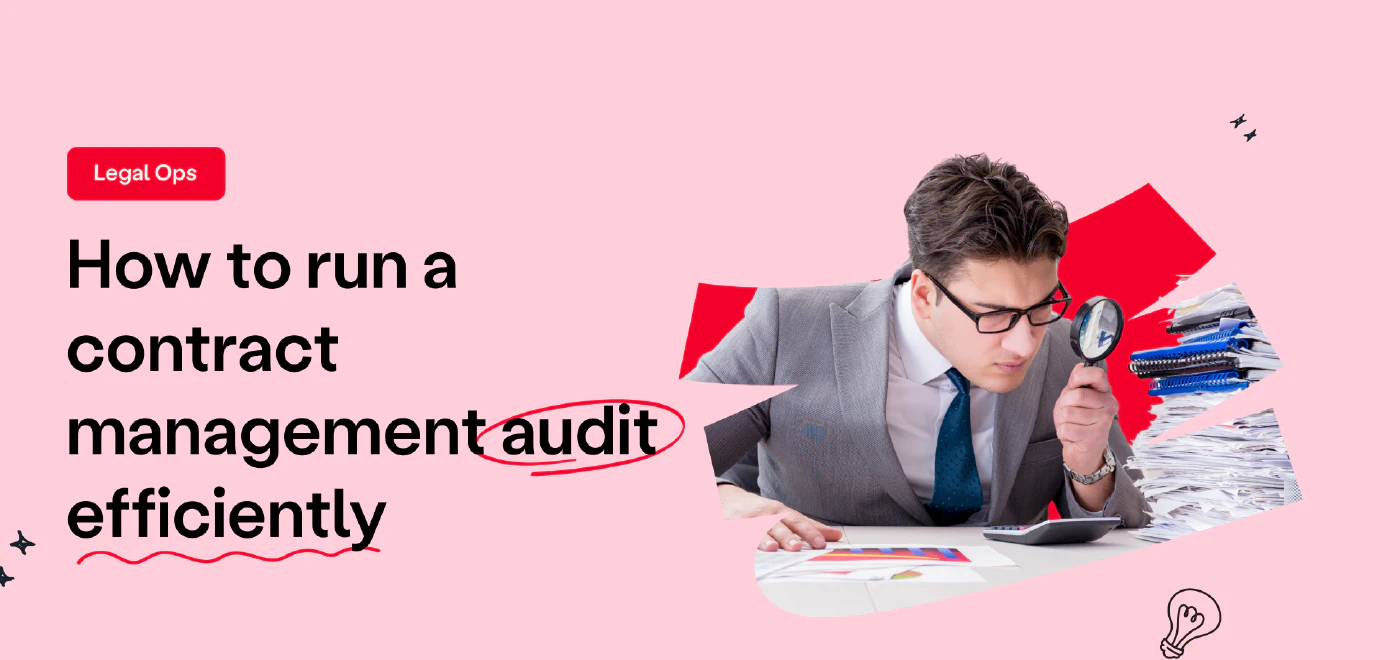
What is a contract management audit
A contract management audit is a systematic and careful check-up on how your company handles contracts, from drafting and signing, all the way to archiving. It doesn’t just look at each agreement itself. It also inspects the entire process around them: how contracts are stored, how you track obligations, how compliance is ensured and how risks are controlled.
In other words, a contract management audit is a deep dive into how your company handles contracts. It’s done to check:
- How contracts are stored
- Who’s managing obligations
- Whether compliance is actually being followed
- And how risks are tracked (or slipping through the cracks)
It’s a full health check of your contract ecosystem.
That includes:
- Policies and workflows
- Approval chains and responsibilities
- Record-keeping and renewals
- Internal compliance and external regulations
The goal is to make sure your contracts are assets, not liabilities.
Why contract management audits matter
Contract audits not only help you catch problems, but also to optimize and safeguard how your business operates; especially by uncovering the contract management mistakes that’ll fail you in audits if left unaddressed.
Here’s what a solid audit helps you achieve:
✅ Identify inefficiencies and risks: Missing obligations, outdated templates, lost documents—audits bring these to light.
✅ Improve compliance and reduce exposure: Audits confirm that your organization is meeting both internal standards and external legal or regulatory requirements.
✅ Find cost-saving opportunities: Many audits uncover unnecessary spending, duplicate agreements, or outdated terms that can be renegotiated.
✅ Standardize and streamline contract handling: Audits often lead to better templates, clearer workflows, and more efficient systems for storing and retrieving contracts.
✅ Strengthen accountability: When every step is documented, who approved what, who signed when, who’s responsible for delivery, it creates a stronger foundation of trust across teams.
When to conduct a contract audit
You don’t need to wait for an issue to justify an audit. In fact, proactive timing is often best.
Here are common situations where an audit is especially valuable:
📅 On a regular cadence: Annual or biennial audits are a smart addition to your governance calendar.
📈 After significant contract growth: As contract volume or complexity increases, so does the risk of oversight. An audit helps ensure you stay in control.
🧩 Following organizational changes: Mergers, restructures, or launching new business units can complicate your contract landscape. It’s a good time to verify everything still functions as intended.
🚨 If issues start to surface: Disputes, missed obligations, or compliance concerns are clear signals that it’s time to take a closer look.
🛠 Before major initiatives: Whether you’re onboarding key vendors, entering new markets, or making large investments, audits help ensure your contracts support your next move, not hinder it.
The takeaway: If there’s growth, change, complexity, or risk in your contract ecosystem, a contract audit can help bring clarity and control.
Before the audit: Preparing for a contract management audit
Good preparation is what sets a smooth, focused audit apart from one that’s disorganized or unproductive. With the right groundwork, you set the stage for clear insights, efficient execution, and real impact.
Here’s how to prepare, and why each step matters.
1. Set the audit scope and objectives
Having clear scope and objectives helps you avoid “audit-paralysis”. Without boundaries, you may end up overwhelmed by hundreds or thousands of contracts and shallow findings.
What to do
- Write down why you perform the audit. Are you checking compliance, renewing contracts, cleaning up old agreements, or reducing risk?
- Define which contracts are included: all contracts, just vendor contracts, only high-value ones, or those expiring soon.
- Set clear success criteria: e.g. “All high-value vendor agreements must have complete contract metadata and renewal dates”, or “No contracts older than 5 years remain unreviewed”.
Example: Say you have some long-term vendor agreements signed between 2018 and 2021. You scope the audit to all vendor contracts older than 3 years, with payments over €100,000, to check whether terms are still favorable and whether renewals or renegotiations are due.
2. Assign roles and responsibilities
A contract audit touches many parts of your business, from legal and procurement to finance and operations. Without clear ownership, you get overlap, missed items, or even blind spots.
What to do
- Appoint a lead auditor who coordinates the audit and keeps track of progress.
- Create a small audit team and involve legal, procurement, finance or operations, depending on your contract types.
- Assign roles: who gathers contracts, who checks payment terms, who checks compliance clauses, who verifies signatures or renewals, who writes findings.
- Set a review board or decision-maker (e.g. head of legal or CFO) who will approve the audit results and follow-up plan.
3. Review policies, controls, and key documentation
The audit is about how you manage them, too. If your internal policies and controls are weak, you may be holding contracts that are misfiled, unsecured, or inconsistent.
What to do
- Audit your internal contract-management policies: Who can approve? How are templates maintained? Where are signed contracts stored? What’s the versioning policy?
- Compare policies to actual practice: Are contracts stored in shared drives, individual mailboxes or spreadsheets? Are older versions kept or overwritten? Are signature logs retained?
- Gather all related documentation: templates, signed copies, amendments, metadata records, approval logs, correspondence, renewal reminders, performance records.
Many companies underestimate the risk of outdated templates. Old templates may contain obsolete clauses, outdated penalties or missing regulatory language. When you audit, check especially that templates used match the latest standard version. Audit guidance from industry sources emphasises updating templates before large-scale audits.
4. Plan the audit and collect necessary data
Without a proper plan and data collection, audits become messy. You may lose track of which contract you already checked, which data source is up to date, or which obligations you still need to verify.
What to do
- Build a simple audit timetable with milestones (e.g. Contract gathering, metadata review, renewal check, risk assessment, findings presentation).
- List data sources: contract repository, shared drives, email archives, signature systems, invoicing/ payment records, renewal trackers.
- Ensure access rights for auditors: verify that auditors can access all relevant contract data while respecting internal permissions.
- Collect historical data: versions of contracts, amendment history, renewal history, performance/ delivery records, compliance records.
Centralizing contract storage before audit significantly reduces audit time and improves accuracy. Systems that still rely on spreadsheets and email are much more likely to miss contracts or misfile key documents.
5. Identify high-risk contracts and focus areas
You rarely have time or resources to deeply review every single contract. Focusing on high-risk, high-value, or high-obligation contracts maximizes audit impact.
What to do
- Flag contracts by value, duration, complexity, external obligations (e.g. service levels, delivery obligations, regulatory exposure), approaching renewal or expiry.
- Prioritize contracts with missing metadata, unclear terms or lack of documentation — these are often where risks hide.
- Review contracts with auto-renewal or penalty clauses, poor management here can lead to unexpected costs or liabilities.
6. Leverage software with audit-trail capabilities
Software like fynk that track audit trails and logs every action automatically is one of the most efficient ways to make an audit reliable, transparent and defensible. Manual logging often misses events or lacks detail.
What to do
- Use tools or CLM platforms that time-stamp every event: creation, edits, approval, signature, version changes, stage transitions.
- Ensure the system logs who did what, identity, timestamp, nature of change, and keeps older versions accessible.
- Use audit logs to generate reports or dashboards, so you can easily spot overdue renewals, missing signatures, or contracts with incomplete metadata.
💡 Did you know: fynk automatically creates a complete audit trail for every contract and version changes? All actions are time-stamped and stored transparently, and the dashboard gives you a real-time overview of missing approvals, upcoming renewals, incomplete metadata or stalled workflows.
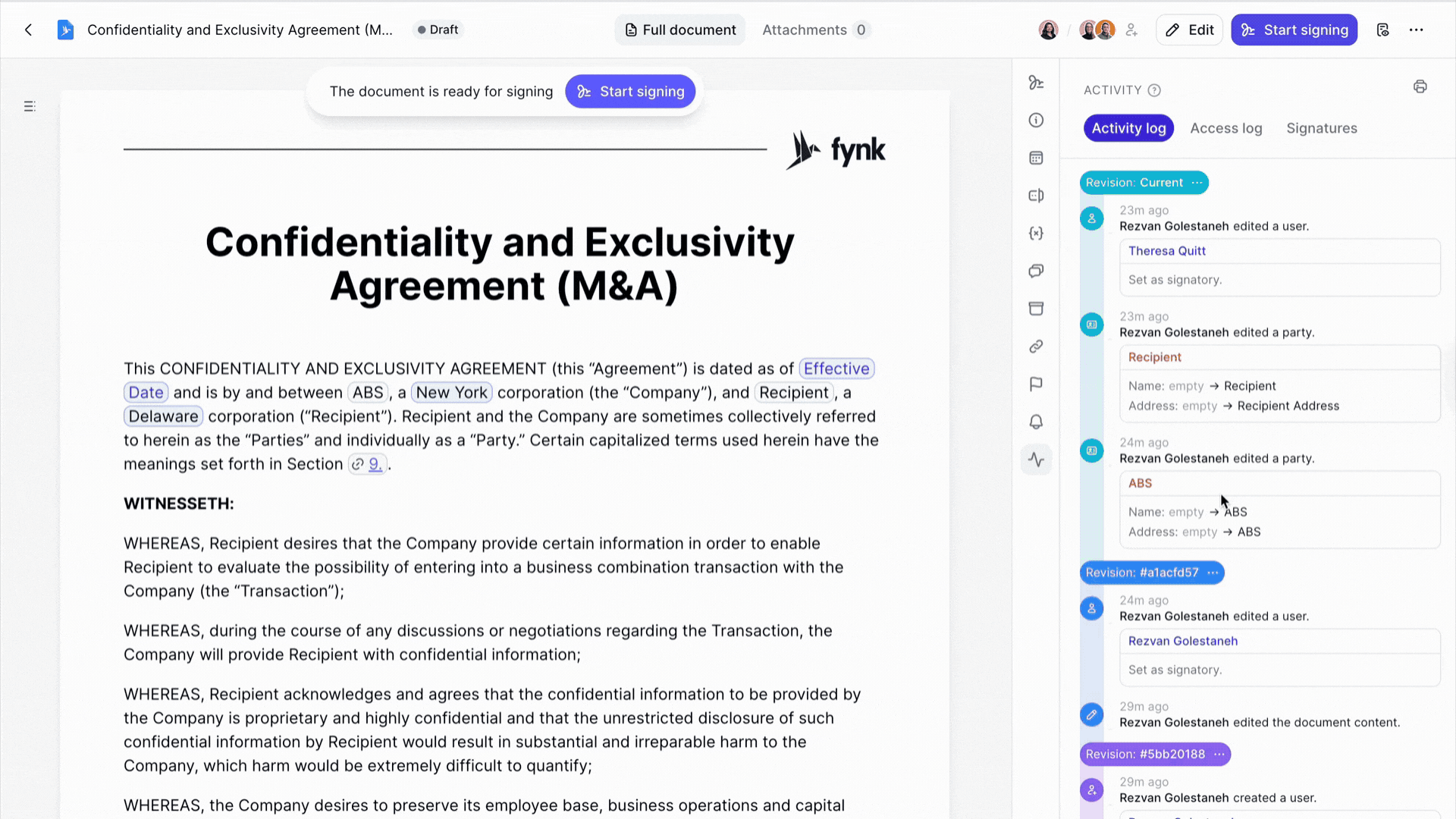


Activity log (Audit trail) in fynk app
During the audit: what to review and how to assess it
1. Review contract terms and critical clauses
- What to review: key clauses such as scope of work, payment/fee terms, deliverables, termination and renewal clauses, confidentiality, liability/indemnity, warranties, data protection or regulatory clauses (if relevant).
- How to assess: check whether the clauses are complete, unambiguous, up-to-date and aligned with current regulation or business policies; ensure no critical clause is missing; compare against your standard / approved contract templates to detect deviations or outdated language.
💡 Did you know: fynk’s AI analysis can automatically analyze contract terms and critical clauses for you? Instead of manually scanning every section, use AI analysis to extract your contracts’ metadata in bulk.
You’ll also get a concise summary of each contract which saves you time and effort.
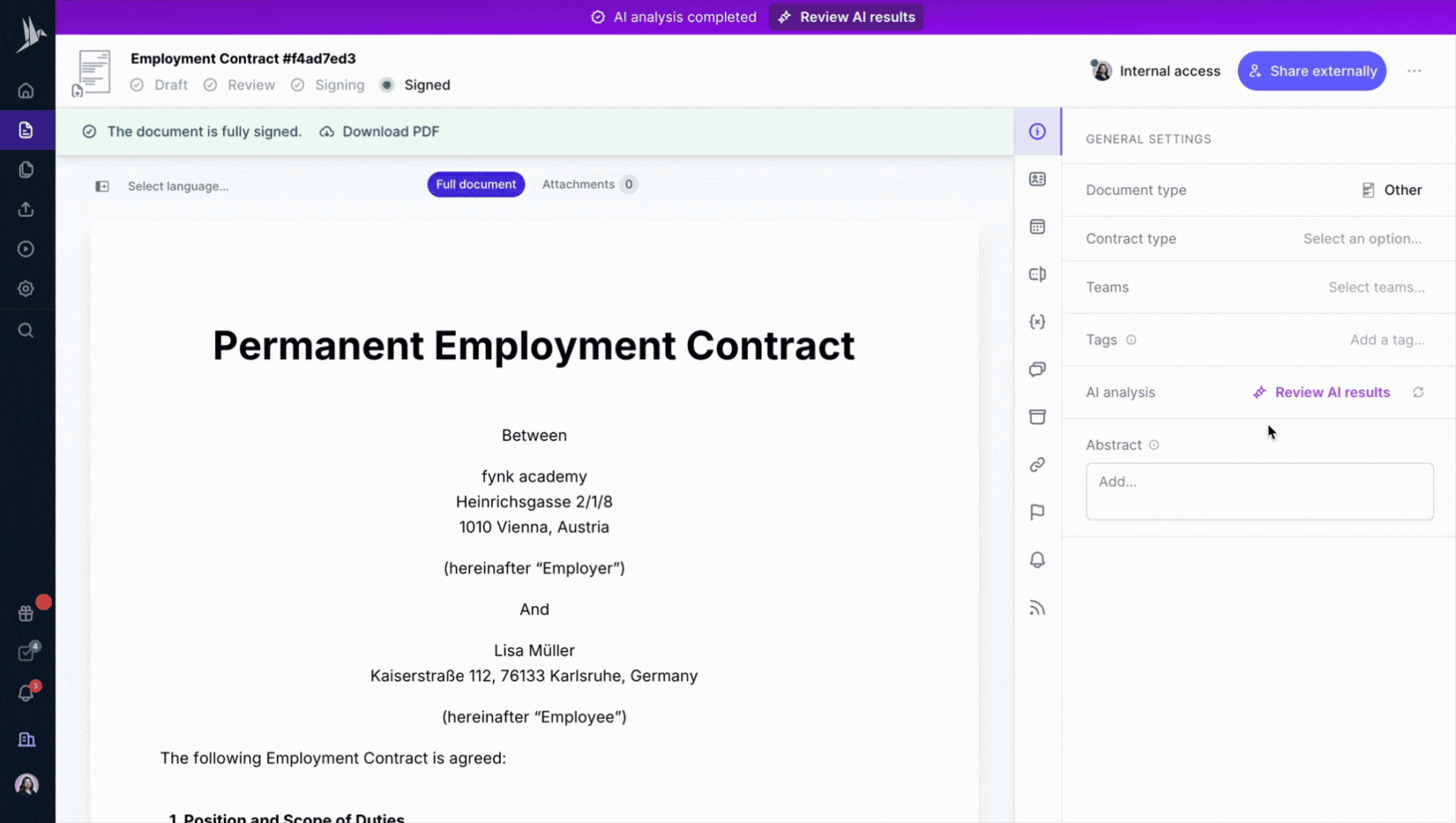


AI analysis in fynk
2. Evaluate approval workflows
- What to review: the process by which contracts are drafted, reviewed, approved and signed, e.g. who is authorized to approve, how many levels of approval exist, whether approvals are documented, time taken, bottlenecks.
- How to assess: check for consistency and compliance with the defined internal workflow (e.g., are all contracts approved by required stakeholders? do approvals happen before signing? are templates used rather than ad-hoc documents?). Also assess whether the process is efficient, i.e. minimal delays, clear responsibilities, low error risk.
fynk makes approval workflows fully automatic and transparent and easy to control? With configurable review steps, role-based permissions and automatic approval routing, fynk ensures every contract is reviewed by the right stakeholders in the right order.
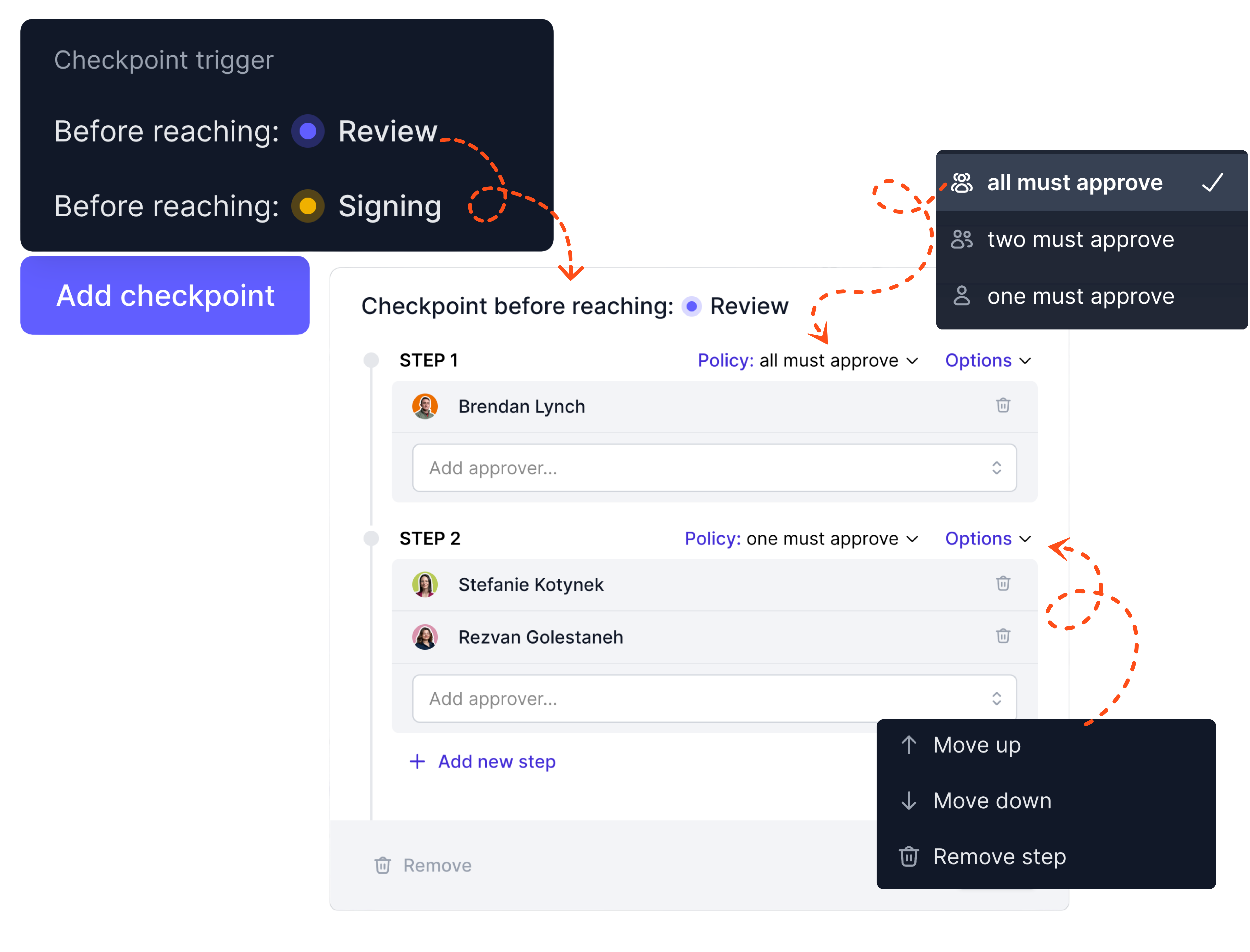


Checkpoints in fynk
3. Test compliance with policies and regulations
- What to review: whether contract terms and contractual practices comply with applicable laws, industry regulations, internal corporate policies (e.g. data protection, confidentiality, finance, compliance, governance).
- How to assess: verify that all regulatory-required clauses are present, that contract handling (storage, signature, renewals) follows internal compliance processes, and that no conflicts exist between contract terms and legal/regulatory requirements. Use a cross-check against relevant legal standards and company policy.
4. Assess vendor and third-party contract management
- What to review: contracts with vendors or third parties (suppliers, service providers, partners), including their terms, performance obligations, compliance clauses, renewal/termination terms, and risk mitigation (e.g. liability, confidentiality, data security).
- How to assess: check that third-party contracts meet internal standards and regulatory requirements; verify that vendor obligations are clearly defined and enforceable; assess whether vendor performance is monitored; watch for undue risk exposure — e.g. weak liability clauses, unclear deliverables, missing audits or compliance obligations.
5. Verify performance obligations and deliverables
- What to review: whether the contract clearly defines what each party must deliver (goods, services, milestones, quality standards), payment terms tied to deliverables, deadlines, acceptance criteria, reporting requirements.
- How to assess: confirm that deliverables, deadlines and acceptance criteria are realistic and sufficiently detailed; check whether the other party has met its obligations (through records, invoices, delivery reports, performance metrics); identify overdue or incomplete deliverables, overpayments or unfulfilled obligations.
6. Analyze risks and internal controls
- What to review: internal controls around contract management (who can approve contracts, version control, storage and retrieval, renewal/termination notifications), risk-related clauses (liability, indemnification, penalties), and how risks are managed (compliance controls, audit trails, oversight).
- How to assess: evaluate whether controls are effective and consistently applied; test whether contract storage and retrieval is reliable; check for segregation of duties (e.g. drafting vs approving), audit trails, and whether risk-bearing clauses are adequate for likely exposure. Flag contracts with high risk but weak controls.
After the audit: reporting, improvements, and next steps
1. Create a clear and actionable audit report
- What to do: produce a formal audit report that summarizes all findings, non-conformities, observations and recommendations. This report should cover where the contract management process is working, where it fails or is weak, and what needs correction.
- Why it matters: only a well-documented audit report ensures transparency, traceability and makes clear what must change, rather than leaving issues implicit or forgotten.
2. Present findings in a structured format
- What to do: structure the report logically, e.g. executive summary, scope, methodology, results (strengths, weaknesses), risk assessment, recommended actions, prioritized remediation plan. Many audit-report guides recommend such a clean layout to ensure readability and clarity.
- Why it matters: a structured presentation makes it easier for stakeholders (management, legal, operations, procurement) to quickly grasp the issues and agree on next steps.
3. Address common findings with recommended actions
- What to do: for recurring issues (e.g. missing clauses, inconsistent approval workflows, lack of tracking for renewals), include concrete recommendations: e.g. update master templates, implement approval-workflow controls, set up renewal alerts, define responsibility. Use risk- and priority-based classification (e.g. critical, high, medium).
- Why it matters: this transforms the audit from a passive overview into a proactive roadmap, otherwise findings remain theoretical and seldom translate into change.
4. Share insights with leadership and stakeholders
- What to do: present the audit results and recommended actions to leadership, management and all relevant departments (legal, procurement, finance, operations). Optionally hold a “conclusion meeting” or “audit debrief” to discuss findings, clarify misunderstandings and align on next steps.
- Why it matters: ensures organisation-wide buy-in, clarity about responsibilities, and commitment to implement changes.
5. Translate findings into improvement plans
- What to do: from the audit report and stakeholder input, derive a concrete improvement plan, specifying which measures will be taken, who is responsible, by when, and how success will be measured. Could include process redesign, template updates, training, or implementing a contract-lifecycle management system.
- Why it matters: only with a clear plan do improvements become actionable, otherwise, the audit risks being a “check-the-box” exercise without real benefit.
6. Improve ongoing contract compliance monitoring
- What to do: set up processes or systems to monitor contract compliance and performance on an ongoing basis, e.g. periodic audits, dashboards for renewals and obligations, regular reviews of active contracts, automated alerts for key dates or performance metrics. This ensures you stay “audit-ready” and proactively manage obligations.
- Why it matters: contract management is dynamic, without ongoing oversight, old problems re-appear, and new risks may emerge. Continuous monitoring helps catch issues early.
💡 Did you know: fynk’s dashboard makes continuous contract compliance monitoring effortless? With real-time views of renewals, obligations, open tasks, missing metadata and upcoming deadlines, you can instantly see where attention is needed and which contracts may pose compliance risks.



fynk user dashboard
How fynk supports a complete, audit-ready contract management audit
fynk provides the structure, transparency, and automation needed to make contract audits faster, cleaner, and far more reliable. Here’s how the platform strengthens every stage of the audit:
- Full traceability with an immutable audit trail
- Dashboards for real-time oversight
- Consistent data through metadata and contract types
- Controlled and compliant approval workflows
- AI-powered contract analysis to extract metadata
- Bulk import and centralized storage
When combined, fynk’s features remove the biggest pain points of a contract management audit and replace them with structure, traceability, and oversight. Here’s how they work together to make the entire audit dramatically easier:
- You always know where every contract is and what happened to it
- You avoid manual hunting for information
- Your contract data is clean, structured, and comparable
- Your processes are consistent, not ad-hoc
- You can review more contracts in less time
- You can include legacy and third-party contracts effortlessly
👉 Ready to simplify your next audit? Try fynk and stay audit-ready all year round.
Searching for a contract management solution?
Find out how fynk can help you close deals faster and simplify your eSigning process – request a demo to see it in action.
Contract management audit checklist
- Do we have a complete and accurate inventory of all active, expired, and archived contracts?
- Are all signed agreements stored in one centralized, secure location?
- Can we easily identify the latest version of every contract without confusion?
- Are amendments and addenda correctly linked to their original agreements?
- Are teams consistently using the latest approved templates?
- Are critical clauses (e.g., termination, liability, confidentiality) always included and up to date?
- Does each contract follow a clearly defined review and approval workflow?
- Are all approval steps time-stamped and traceable to a specific user?
- Are any approval stages frequently skipped or delayed?
- Do contracts include all required compliance, regulatory, or data protection clauses?
- Are contract obligations, deliverables, and SLAs actively tracked and monitored?
- Are renewal dates, notice periods, and termination windows properly documented?
- Are key metadata fields (value, dates, parties, renewal terms) complete and accurate?
- Is access to sensitive contracts controlled through proper permissions and roles?
- Do we maintain an audit trail for edits, approvals, signatures, and reviewer actions?
- Are high-value or high-risk contracts consistently escalated to legal or compliance?
- Are vendor and third-party performance obligations regularly reviewed?
- Are auto-renewal clauses monitored to avoid unintended renewals?
- Do we generate regular reports or dashboards on contract status and risks?
- Are audit findings translated into documented action items and process improvements?
Please keep in mind that none of the content on our blog should be considered legal advice. We understand the complexities and nuances of legal matters, and as much as we strive to ensure our information is accurate and useful, it cannot replace the personalized advice of a qualified legal professional.

Table of contents
- What is a contract management audit
- Why contract management audits matter
- When to conduct a contract audit
- Before the audit: Preparing for a contract management audit
- During the audit: what to review and how to assess it
- After the audit: reporting, improvements, and next steps
- How fynk supports a complete, audit-ready contract management audit
- Contract management audit checklist
Want product news and updates? Sign up for our newsletter.
Other posts in Legal Ops

How to use audit trail to track changes in legal documents
Handling legal documents means managing risk, accountability and compliance, not just text on a page. As those …

How to run a contract management audit efficiently
Contract management audits are one of the most effective ways to understand whether your contract processes …
Contracts can be enjoyable. Get started with fynk today.
Companies using fynk's contract management software get work done faster than ever before. Ready to give valuable time back to your team?
Schedule demo

